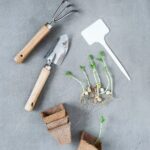Are you interested in exploring vegetable gardening in containers ideas? Whether you have limited outdoor space or simply want to add a touch of green to your home, container gardening offers a versatile and rewarding way to grow your own fresh produce. In this article, we will explore the numerous benefits of vegetable gardening in containers and provide valuable tips and advice for creating thriving container gardens.
Container gardening allows individuals with limited space, such as apartment dwellers or those with small urban yards, to experience the joy of growing their own vegetables. It also provides the opportunity for gardeners to easily move their plants around based on sunlight or weather conditions. From tomatoes to peppers, lettuce to herbs, there are countless options for growing vegetables in containers that can thrive in various environments.
In addition to its space-saving benefits, container gardening also allows for greater control over soil quality and drainage, reducing the risk of pests and diseases that can often plague traditional garden beds. With the right knowledge and techniques, anyone can create a successful and bountiful container vegetable garden.
So whether you’re a seasoned gardener looking for new challenges or a beginner eager to try your hand at growing your own food, this article will guide you through the exciting world of vegetable gardening in containers.
Choosing the Right Containers for Your Vegetable Garden
When it comes to vegetable gardening in containers, choosing the right containers is crucial for the success of your garden. The container you choose will directly impact the growth and health of your vegetables, so it’s important to make an informed decision.
Size and Depth
The first thing to consider when choosing containers for vegetable gardening is the size and depth. Different vegetables require different depths of soil for their roots to grow and thrive. For example, root vegetables like carrots and radishes need deeper containers, while shallow-rooted plants like lettuce and herbs can thrive in shallower containers. It’s important to research the specific needs of the vegetables you want to grow and select containers that accommodate those needs.
Material
The material of the container is another important factor to consider. While plastic containers are lightweight and durable, they can also heat up quickly in the sun, potentially damaging plant roots. Terracotta or clay pots are breathable and allow air to circulate around the roots, but they can dry out more quickly than other materials.
Wooden containers are sturdy and provide good insulation for plant roots but may deteriorate over time. Consider the pros and cons of each material before making a decision.
Drainage
Proper drainage is essential for container gardening success. Make sure your chosen containers have drainage holes at the bottom to prevent waterlogged soil, which can lead to root rot. It’s also a good idea to elevate your containers slightly off the ground using pot feet or bricks to aid in drainage.
By carefully considering factors such as size, depth, material, and drainage when choosing containers for your vegetable garden, you’ll be setting yourself up for a successful growing season. With the right containers, you’ll be on your way to enjoying a bountiful harvest of fresh vegetables right from your own home.
Selecting the Best Vegetables for Container Gardening
When it comes to vegetable gardening in containers, selecting the right vegetables is key to a successful and bountiful harvest. Not all vegetables thrive in container gardens, so it’s important to choose varieties that are well-suited for limited space and shallow soil. Here are some of the best vegetables for container gardening:
Tomatoes
Tomatoes are one of the most popular choices for container gardening. They come in a variety of sizes, from large beefsteak tomatoes to small cherry tomatoes, making them versatile for container planting. Look for determinate or bush varieties that are more compact and suited for small spaces.
Peppers
Peppers are another excellent choice for container gardening. They do well in pots and grow prolifically, providing you with a continuous harvest throughout the growing season. Choose compact varieties like bell peppers or chili peppers for your container garden.
Leafy Greens
Leafy greens such as lettuce, spinach, and kale are perfect for container gardening, especially if you have limited space. They have shallow roots and can be grown closely together in a single pot, making them ideal for small patio gardens or balconies.
Herbs
Herbs like basil, parsley, and cilantro are not only easy to grow in containers but also add flavor and freshness to your cooking. They thrive in pots and require minimal care, making them a great choice for beginner gardeners or those with limited time.
Incorporating these vegetable options into your container garden will not only provide you with a bountiful harvest but also add visual interest to your outdoor space. With the right selection of vegetables, your container garden can be both functional and aesthetically pleasing.
Container Gardening Soil and Fertilizer Tips
When it comes to vegetable gardening in containers, the soil and fertilizer you use play a crucial role in the success of your garden. The right combination can provide the necessary nutrients for healthy plant growth and bountiful harvests. Here are some essential tips for container gardening soil and fertilizer:
- Use high-quality potting mix: Choose a well-draining potting mix specifically formulated for container gardening. Avoid using garden soil, as it can become compacted and hinder root growth.
- Consider adding organic matter: Incorporating compost or aged manure into your potting mix can enrich the soil with essential nutrients, improve drainage, and promote beneficial microbial activity.
- Fertilize regularly: Container-grown vegetables need regular feeding since nutrients leach out of the containers with frequent watering. Use a balanced, slow-release fertilizer or liquid fertilizer according to the instructions on the product label.
In addition to soil and fertilizers, consider using mulch in your container garden to help retain moisture, regulate soil temperature, and suppress weed growth. Organic mulches like straw, wood chips, or shredded leaves are excellent choices for container gardens.
Ultimately, maintaining healthy soil is key to successful vegetable gardening in containers. Regularly monitor your plants’ nutrient needs to ensure they receive adequate nourishment throughout their growing season. By paying attention to soil quality and providing proper fertilization, you can enjoy a thriving container vegetable garden with abundant yields of fresh produce.
Tips for Watering and Maintenance of Container Vegetable Gardens
When it comes to vegetable gardening in containers, proper watering and maintenance are essential for the success of your garden. Here are some tips to ensure that your container vegetables thrive:
- Use the right watering techniques: With container gardening, it’s important to water your vegetables correctly. Keep in mind that containers can dry out quickly, especially during hot weather. Make sure to water deeply and consistently, allowing the soil to absorb the moisture.
- Check the soil moisture regularly: One way to determine if your container plants need water is by carefully checking the soil moisture. Stick your finger into the soil up to your knuckle – if it feels dry, then it’s time to water.
- Consider self-watering containers: If you’re concerned about keeping up with the watering needs of your vegetable garden, consider investing in self-watering containers. These containers have built-in reservoirs that provide a steady supply of water to the plants.
In addition to proper watering, maintenance is also crucial for the health of your container vegetable garden. Here are some maintenance tips to keep in mind:
- Prune and trim regularly: As your container vegetables grow, be sure to prune and trim them as needed. This will promote healthy growth and prevent overcrowding within the limited space of a container.
- Fertilize appropriately: Container-grown vegetables may require more frequent feeding than those grown in traditional gardens. Be sure to follow a fertilizing schedule and use a high-quality fertilizer suitable for vegetable plants.
- Monitor for pests and diseases: Regularly inspect your container plants for any signs of pests or diseases. Early detection is key in preventing potential damage to your vegetable garden.
By following these watering and maintenance tips, you can ensure that your container vegetable garden thrives and yields a bountiful harvest of fresh produce for you to enjoy.
Creative Container Ideas for Small Spaces
One of the advantages of vegetable gardening in containers is the versatility it offers, especially for individuals with limited outdoor space. Whether you have a small balcony, patio, or even just a sunny windowsill, there are numerous creative container ideas that can maximize your growing area.
Hanging planters, vertical gardens, and tiered shelves are all excellent options for those with limited space. These solutions not only make the most of your available space but also add visual interest to your garden.
Another innovative approach to container gardening in small spaces is the use of repurposed items such as old buckets, crates, or even plastic bottles. These unconventional containers not only provide an eco-friendly option but also add a unique touch to your garden. Additionally, using hanging shoe organizers or wall-mounted pockets can create additional planting space without taking up valuable square footage.
For urban dwellers or those with little access to outdoor areas, indoor vegetable gardening in containers can be a great way to bring nature inside. Utilizing windowsills, countertops, and even vertical wall space with compact planters allows individuals to grow their own produce regardless of limitations. Incorporating a mix of herbs and compact vegetable varieties into indoor container gardens can provide both culinary and aesthetic benefits.
| Container Idea | Description |
|---|---|
| Hanging Planters | Utilize vertical space by hanging plants from ceilings or railings |
| Repurposed Items | Upcycle old containers such as buckets or crates for unique and eco-friendly planters |
| Indoor Gardens | Create mini gardens on windowsills or countertops using compact planters |
Vertical Gardening
When space is limited, vertical gardening is a fantastic way to maximize your vegetable yield. By utilizing wall space, trellises, and hanging baskets, you can grow a variety of vegetables even in the smallest of areas. One of the most popular methods of vertical gardening is using trellises for vining plants such as tomatoes, cucumbers, and peas. These plants can be trained to grow upwards, saving valuable ground space.
Another creative idea for small spaces is using hanging baskets or wall-mounted planters. Lettuce, herbs, and small pepper varieties are ideal for this type of vertical gardening. These containers not only save space but also add visual interest to your outdoor living area.
In addition to trellises and hanging containers, consider using vertical garden towers or stacked planters. These innovative designs allow you to grow multiple plants in a small footprint. They are perfect for home gardeners who want to make the most out of their limited outdoor space.
Lastly, don’t forget about utilizing mesh or netting systems to encourage climbing vegetables such as beans and peas to grow vertically. This not only saves ground space but also makes harvesting easier when the time comes. With these ideas in mind, anyone can create a successful and productive vertical vegetable garden.
| Vertical Gardening Ideas | Benefits |
|---|---|
| Trellises for vining plants | Saves ground space and adds visual interest |
| Hanging baskets and wall-mounted planters | Perfect for lettuce, herbs, and small pepper varieties |
| Garden towers and stacked planters | Allows multiple plants in a small footprint |
| Mesh or netting systems | Encourages climbing vegetables for easy harvesting |
Pest and Disease Management in Container Vegetable Gardens
One of the challenges of vegetable gardening in containers is the increased vulnerability to pests and diseases due to the confined space. However, with proper management and preventive measures, you can effectively protect your container garden from these threats.
To start with, it’s important to regularly inspect your container plants for any signs of pest infestation or disease development. Look out for common pests such as aphids, whiteflies, and caterpillars, as well as symptoms of fungal or bacterial diseases like wilting, yellowing leaves, or unusual spots and discoloration.
In addition to regular monitoring, implementing natural pest control methods can help prevent an infestation before it becomes a serious problem. This can include introducing beneficial insects like ladybugs or lacewings to control pests, using insecticidal soap or neem oil sprays, or even planting companion plants known for repelling harmful insects.
Furthermore, practicing good gardening hygiene by removing any dead or diseased plant material immediately can also minimize the risk of spreading diseases within your container garden. By taking proactive measures and staying vigilant against potential threats, you can create a thriving and healthy vegetable garden in containers.
Harvesting and Enjoying the Fruits of Your Container Garden
After months of hard work, it’s finally time to enjoy the fruits of your labor in your container garden. Harvesting fresh vegetables from your own home-grown garden is a rewarding experience that allows you to savor the flavors of your labor. Whether you’re picking plump tomatoes from a hanging basket or crisp lettuce from a window box, there’s nothing quite like enjoying vegetables that you’ve grown yourself.
One of the joys of container gardening is that you can harvest vegetables as they ripen, ensuring that you get the freshest produce possible. Keep an eye on your plants and pick them as soon as they are ready. This not only gives you delicious vegetables at their peak flavor but also encourages further growth and production from your plants.
In addition to traditional harvesting, one unique benefit of container gardening is the ability to bring your containers indoors during colder months, giving you the opportunity to continue harvesting fresh produce year-round. This flexibility allows for a continuous supply of home-grown vegetables, no matter the season.
With proper care and attention to seasonal changes, you can enjoy fresh cucumbers in December or sweet peas in early spring-all from the convenience of your containers indoors. The versatility and satisfaction of harvesting from a container garden truly knows no bounds.
Conclusion
In conclusion, vegetable gardening in containers offers a multitude of benefits and opportunities for individuals to cultivate their own fresh produce, regardless of the amount of outdoor space available. From apartment balconies to small patios, container gardening allows anyone to enjoy the satisfaction of growing and harvesting their own vegetables. With the right containers, soil, and plant selection, even those with limited gardening experience can find success in this rewarding activity.
By choosing the appropriate containers for your vegetable garden and implementing proper soil and fertilizer techniques, you can ensure that your plants thrive. Additionally, utilizing vertical gardening techniques can maximize space and allow for a greater variety of vegetables to be grown within a limited area. With careful maintenance and pest management strategies, you can safeguard your container garden from potential threats while enjoying a bountiful harvest.
Whether you are looking for creative container ideas for small spaces or seeking advice on how to manage pests and diseases in your container garden, this article aims to provide valuable information to help you embrace the joy of vegetable gardening in containers. By following these tips and ideas, individuals can feel empowered to start their own thriving container gardens and experience the rewards of harvesting their home-grown produce.

Welcome to my gardening blog! I am passionate about plants and enjoy sharing my knowledge and experiences with others. In this blog, I will write about everything related to gardening, from tips on how to get started to updates on my own garden projects.





